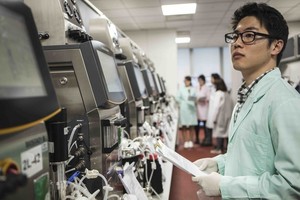The monoclonal antibodies’ (mAbs) market is dominant among therapeutic biologicals. Between 2013 and 2017, it has witnessed the approval of 11 biosimilars and 33 new molecules by the regulatory authorities in the EU and the US [1]. A foreseen increase in demand arising from both the western world and several developing countries requires a productivity increase at the same time that the biopharmaceutical industry is being pressured to reduce the costs of life-saving drugs.
Alternative mAb purification strategies: a tool to increase global access to biotherapeutics?
Biosimilars/Research
|
Posted 31/08/2018
 0
Post your comment
0
Post your comment

In terms of purification strategies, mAbs’ bioprocessing has been dominated by process platforms whereby clarification is the initial task followed by product capture (usually by protein A affinity chromatography), viral inactivation, two chromatographic polishing steps and a final virus removal step before the product is buffer-exchanged into formulation buffer.
Grilo et al. from the Institute for Bioengineering and Biosciences, Instituto Superior Técnico, Lisboa, Portugal challenge this concept and present a technically promising and economically comparable alternative whereby capture is achieved by phenylboronate multimodal chromatography (PBC) and the first polishing step is monolithic anion-exchange chromatography (AEX) [2]. This alternative has been studied in the authors’ group from a technical perspective and the optimal conditions achieved have been compared through process simulations of the platform strategy usually employed by industry.
A 25 g/L process run in perfusion mode for a high-demand product is considered, having host cell proteins, aggregates and DNA as the main impurities. The main differences lie on the downstream side: the PBC has a binding capacity comparable to that of protein A but the latter resin has a 4-times shorter lifespan. Since the resin cost is marginal, PBC becomes a much cheaper option. The yield and selectivity are, however, slightly lower. The second unit operation change is the replacement of the traditional bind-and-elute cation-exchange chromatography (CEX) polishing step by monolithic AEX operated in flow-through mode. The lifespan of the monoliths is 50% of that of the resin and the dynamic binding capacity is lower at comparable resin costs. However, the operation is significantly quicker, as it has the ability to stand higher linear velocities, and it also uses cheaper buffer formulations.
Process simulations were used to generate process data so that an economic analysis could be performed. To this goal, capital investment and operating costs were considered in great detail. An investment plan has been developed assuming that the project could be financed in equal shares by the company and a bank loan with a 5% interest rate, to support both R & D expenses and capital costs, to be paid in 10 years. Finally, a cash-flow model was developed incorporating all earns and expenses and considering the appropriate taxes. This model was used for several indicators of economic performance: the net present values, returns on investment, payback times and internal rates of return (IRRs) are comparable. Nevertheless, the calculations of Grilo et al. show that the newly suggested route can provide a 20% reduction in operating costs while the capital costs are similar. In the end, the performance indicators for the new process are slightly better (IRR of 69% compared to 68% for the traditional, protein A-based process).
This work compares a highly-optimized process with a newly developed one. Their similar performance should motivate the optimization of the newly suggested route, both in technical and economic terms, leading to a possibly better strategy able to replace protein A affinity chromatography, making bioprocessing more affordable and contributing to increasing global access to biologicals.
Conflict of interest
The author of the research paper [2] did not provide any conflict of interest statement.
Abstracted by António Lima Grilo, Institute for Bioengineering and Biosciences, Department of Bioengineering, Instituto Superior Técnico, Universidade de Lisboa, No. 1, Av. Rovisco Pais, PT-1049-001, Lisbon, Portugal.
Institute for Bioengineering and Biosciences, Department of Bioengineering, Instituto Superior Técnico, Universidade de Lisboa, No. 1, Av. Rovisco Pais, PT-1049-001, Lisbon, Portugal.
References
1. Grilo AL, Mantalaris A. The increasingly human and profitable monoclonal antibody market. Trends Biotechnol. 23 Jun 2018. doi:10.1016/j.tibtech.2018.05.014. [Epub ahead of print]
2. Grilo AL, Mateus M, Aires-Barros MR, Azevedo AM. Monoclonal antibodies production platforms: an opportunity study of a non-protein-A chromatographic platform based on process economics. Biotechnol J. 2017;12(12). doi: 10.1002/biot.201700260. Epub 2017 Oct 6
Permission granted to reproduce for personal and non-commercial use only. All other reproduction, copy or reprinting of all or part of any ‘Content’ found on this website is strictly prohibited without the prior consent of the publisher. Contact the publisher to obtain permission before redistributing.
Copyright – Unless otherwise stated all contents of this website are © 2018 Pro Pharma Communications International. All Rights Reserved.
News
FDA approves six denosumab biosimilars
EMA recommends approval for four biosimilars targeting three therapies
General
Samsung Bioepis wins Pyzchiva case; Regeneron patent rulings threaten foreign biosimilars
Chinese biosimilars go global: growth, partnerships, and challenges
What is the future for the US biosimilar interchangeability designation

Biosimilars/Research Posted 05/06/2025
Biosimilar clinical efficacy studies: are they still necessary?

Biosimilars/Research Posted 27/05/2025
The best selling biotechnology drugs of 2008: the next biosimilars targets








Post your comment